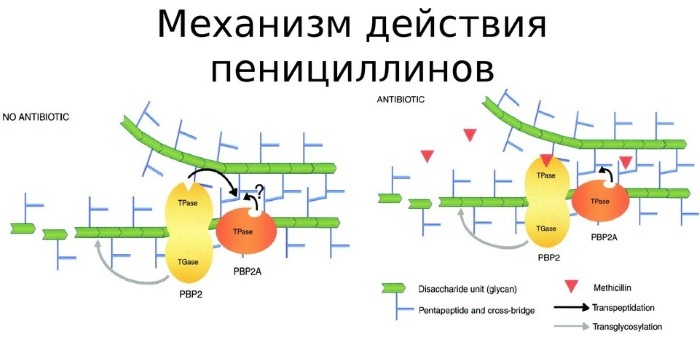The drug Klacid (125 mg) is a modern antibioticwith a powerful effect. This semi-synthetic antimicrobial drug has been used in medical practice for over 30 years. It is used to treat children and adult patients from infectious and inflammatory pathologies. The price of the drug in different pharmacies varies.
Record content:
- 1 Composition, release form, price
- 2 Mechanism of action
- 3 Who is the medicine indicated for?
- 4 Contraindications and side effects
- 5 How to dilute the product?
- 6 Instructions for use
- 7 special instructions
- 8 Overdose
- 9 Efficiency
- 10 Drug interactions
- 11 Correct storage
- 12 Video about Klacida
Composition, release form, price
The main substance in the medicine is clarithromycin. Powder for preparation of oral solution (125 mg / 5 ml). The price of the product is approximately 700 rubles.
Mechanism of action
Similar to other macrolide antibiotics, clarithromycin blocks the synthesis of protein molecules in bacteria:
- At the same time, it binds to the active center of the 50S-subunit of the ribosome and inhibits the synthesis of the peptide chain in bacterial cells.
- By blocking the synthesis of the 50S-subunit itself (this additional effect of macrolides was recently established.)
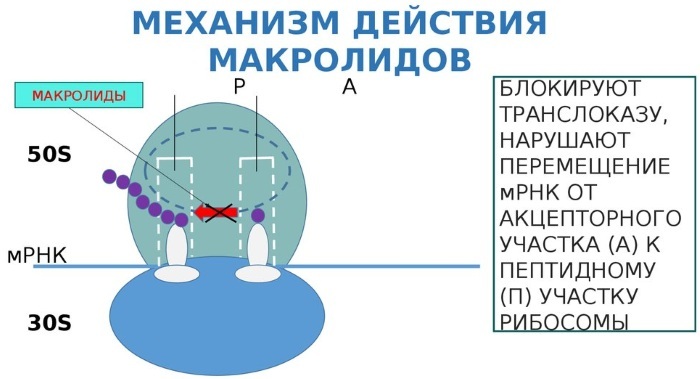
In terms of influence on these 2 processes, clarithromycin is 2 times more potent than erythromycin, and 33 times more powerful than azithromycin. Presumably, the effectiveness of clarithromycin against a variety of pathogens is due to these properties.
Macrolides in low and medium doses act bacteriostatically, however, when taken in large doses, they are capable of producing a bactericidal effect on streptococci that are in the growth phase.
One of the first synthesized macrolide antibiotics, erythromycin, is not effective in the treatment of infectious pathologies caused by Haemophilus influenzae, and clarithromycin strongly affects this pathogen, due to its active metabolite.
This substance is 3 times more potent on Haemophilus influenzae than clarithromycin. Also, clarithromycin and 14-hydroxyclarithromycin act synergistically (mutually reinforcing the effects).
Klacid (125 mg) for children, the price of which is low, is an effective drug used against Haemophilus influenzae, one of the most common pathogens of infectious pathologies of bronchopulmonary systems.
Who is the medicine indicated for?
The drug is used to treat a number of the following infectious pathologies:
- acute otitis media;
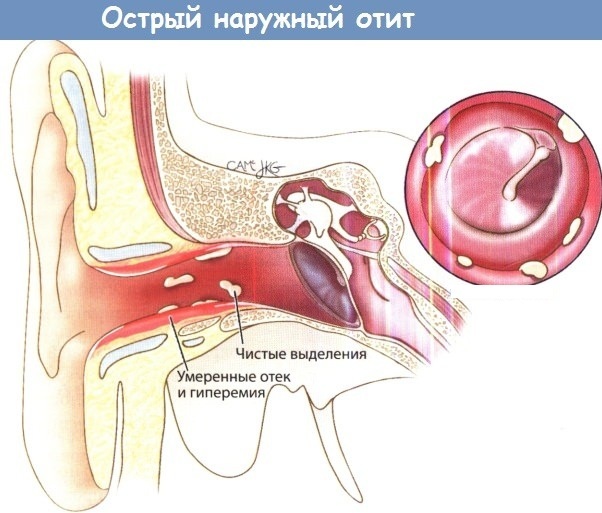
- localized infectious pathologies that are caused by bacteria of the species Mycobacterium kansasii, Mycobacterium fortuitum and Mycobacterium chelonae;
- mycobacterial infectious diseases caused by bacterial strains of the species Mycobacterium intracellulare, as well as the species Mycobacterium avium;
- infectious pathologies of soft tissues and skin;
- infectious pathologies of the respiratory system.
Clarithromycin has a powerful therapeutic effect in ulcer disease and gastritis. It is highly resistant to gastric hydrochloric acid. Due to its lipophilicity, the drug easily penetrates into the tissues of the body. At the same time, its optimal levels are created in tissues and biological fluids.
In the presence of gastrointestinal diseases, dysbiosis often develops. Due to the broad spectrum of action of clarithromycin on gram-negative and gram-positive bacteria, appears the ability to sanitize the intestines and tissues of the oral cavity, while the drug comprehensively corrects the composition of the microflora Gastrointestinal tract.
An additional big plus of clarithromycin is its synergism with agents from the class of proton pump inhibitors against 91% of the studied bacterial strains that cause gastritis and peptic ulcer disease.
Due to these pharmacological properties, clarithromycin is the only representative macrolide antibiotics, which is highly effective in the treatment of Helicobacter pylori infectious pathology.
Contraindications and side effects
Contraindications to the use of Klacid are conditions such as:
- the patient has fructose intolerance;
- glucose-galactose malabsorption;
- deficiency of an enzyme such as sucrase-isomaltase;
- lactation;
- porphyria;
- the presence in the patient's history of cholestatic jaundice or hepatitis, which arose as a result of clarithromycin treatment;
- the use of Klacid in combination with colchicine in those patients who have renal or liver dysfunction;
- combined treatment with clarithromycin and statins, mainly metabolized by CYP3A4 (possibly myopathy, including rhabdomyolysis);
- the presence of both renal and hepatic insufficiency, proceeding in a severe form;
- hypokalemia;

- a history of cardiac pathologies: ventricular tachycardia of the "pirouette" type, ventricular arrhythmia, or prolongation of the QT interval;
- combining clarithromycin with the following agents: oral midazolam, ergot alkaloids, terfenadine, pimozide, cisapride, and astemizole;
- high susceptibility to other agents from the macrolide class and to the constituent substances of Klacid.
The agent is taken with caution in the following conditions:
- diabetes mellitus, since the drug contains sucrose;
- current pregnancy;
- the presence of severe bradycardia (if the pulse is below 50 beats / min);
- the combination of class IA and class III antiarrhythmics and clarithromycin;
- the presence of ischemic heart disease;
- hypomagnesemia (lack of magnesium);
- severe heart failure;
- taking drugs from the group of calcium channel blockers metabolized by CYP3A4 in combination with clarithromycin;
- combined administration with drugs that activate CYP3A4;
- taken in combination with drugs metabolized by CYP3A;
- combined use with drugs from the benzodiazepine group;
- myasthenia gravis (increased intensity of pathology symptoms);
- moderate and severe hepatic and / or renal failure.
If there is a pregnancy (especially its first trimester), treatment with Klacid is possible only if there is no other suitable treatment and the expected benefit to the mother is higher than the estimated risk to embryo. Clarithromycin is excreted in milk, so if the medicine is used while breastfeeding, the baby is not breastfeeding.
When using this remedy, vertigo may appear, symptoms of confusion, dizziness, disorientation may begin.
Therefore, in the process of managing technical means and engaging in other activities that have a high danger, and in which a high concentration of attention is required, as well as the speed of mental and physical reactions, an extreme caution.
Klacid (125 mg for) children, the price of which is acceptable, sometimes, when taken, causes:
- changes in liver function tests;
- vasodilation (vasodilation);
- pain in the abdomen, nausea, symptoms of dyspepsia, vomiting and diarrhea;
- heavy sweating;
- violation of circadian rhythms in the form of insomnia, headaches;
- an allergy manifested in the form of a skin rash;
- perversion of taste, dysgeusia.
How to dilute the product?
To prepare a solution for oral use (60 ml (125 mg / 5 ml)), you must do the following manipulations:
- gradually pour water into the bottle until the level of the mark on the bottle is reached;
- shake the bottle with the solution.
Instructions for use
A solution of the drug is allowed to be used regardless of the time of intake and the type of food. If the pathology is caused by non-mycobacterial pathogens, then the dose of Klacid per day is 7.5 mg / kg 2 r / d (the highest permitted dose is 0.5 g 2 r / d). The average duration of therapy is 5-10 days (it depends on the type of pathogen of the pathology and the patient's condition).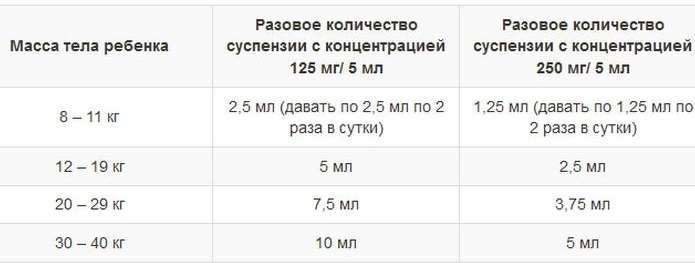
Klacid (125 mg) for children with mycobacterial infections is recommended to be used in a daily dosage of 7.5-15 mg / kg 2 r / d. The relatively low price allows you to use the drug in such a dosage. The dosage for children with creatinine clearance below 30 ml / min is reduced by 2 times.
special instructions
With prolonged use of antibiotics, fungal and bacterial colonies that are insensitive to the drug may appear in the body. If superinfection has developed, then treatment is already prescribed to eliminate it.
When taking Klacid, severe liver dysfunction may occur, but it is more often reversible. There are cases of development of liver failure, which led to death, more often they were associated with severe pathologies in patients and / or the combination of clarithromycin with other medicines.
If there are signs of hepatitis (painful sensations in the abdomen during palpation, itching, dark urine, jaundice, lack of appetite), you should immediately stop treatment with this medicine.
If there are liver pathologies with a chronic course, the doctor should monitor the level of serum enzymes.
In the implementation of therapeutic measures with clarithromycin (and other antibacterial drugs), there were patients who develop pseudomembranous colitis, characterized by mild to severe severity. Under the influence of antibacterial drugs, the state of the intestinal microflora can be disturbed, this can stimulate the growth of bacteria such as C.difficile.
If patients develop diarrhea as a result of therapy with antibacterial drugs, then pseudomembranous colitis, which is caused by the pathogen Clostridium difficile, should be suspected.
At the end of the course of antibiotic treatment, the patient should be monitored. In medical practice, there have been cases when pseudomembranous colitis occurred 2 months after the end of antibiotic therapy.
Taking Klacid with severe bradycardia, the patient has severe heart failure, hypomagnesemia, ischemic heart disease, and with combined use with class IA and III antiarrhythmics, an increase QT interval. Therefore, a frequent study of the electrocardiogram is necessary for the timely detection of this pathology.
To clarithromycin, other antibacterial drugs from the macrolide class, to clindamycin and lincomycin, cross-tolerance may occur.
Since the resistance of Streptococcus pneumoniae to antibiotics from the macrolide class is becoming higher, then before therapy clarithromycin in patients with community-acquired pneumonia, it is necessary, using testing, to determine the sensitivity of the pathogen to medicine.
In the presence of nosocomial pneumonia, a combination of Klacid with other antibacterial drugs is used.
Bacteria, causative agents of infectious pathologies of soft tissues and skin, often have resistance to drugs from the macrolide class. As a consequence, a test is needed to determine the sensitivity of these bacteria.
Klacid (125 mg) for children, the price of which varies in different pharmacies, and other drugs from the class macrolides are used for infectious pathologies such as erysipelas and acne, and when it is impossible to use penicillin.
If there is an acute pathology due to a strong susceptibility to the drug (for example, anaphylactic shock), you should immediately stop using Klacid and start therapy to eliminate pathological reactions.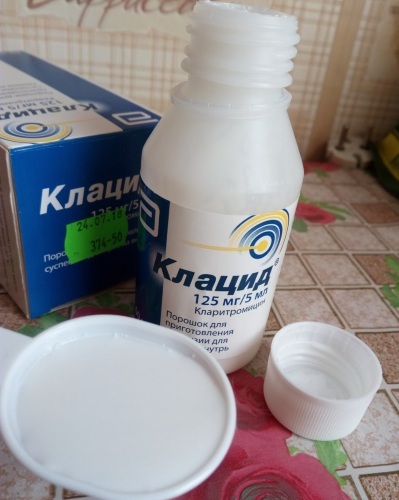
When using Klacid, patients sometimes had a worsening of the signs of myasthenia gravis. During simultaneous use with warfarin or drugs from the group of indirect anticoagulants, prothrombin time and INR should be monitored. It should be borne in mind that the composition of the drug contains sucrose, this is important for patients with diabetes mellitus.
Overdose
If an excessive dose of the drug is taken, the patient needs to induce vomiting to remove the drug from the gastrointestinal tract, perform gastric lavage and perform medical procedures aimed at eliminating symptoms poisoning. Peritoneal dialysis and hemodialysis are almost ineffective in this condition, and this also applies to other drugs from the macrolide class.
Efficiency
Klacid (125 mg) for children, the price of which, taking into account the effectiveness of the drug, is quite low, is a strong antibiotic. Now there is a large world experience in the use of clarithromycin for the treatment of children, and its powerful therapeutic effect in the treatment of infectious pathologies has been proven.
Drug interactions
Medicines that activate CYP3A sometimes accelerate the clearance of clarithromycin.
A number of drugs can change the level of clarithromycin in the patient's body, these are: insulin and hypoglycemic drugs for oral administration use, antiviral drug ritonavir, antifungal drug fluconazole, rifapentine, etravirine, rifabutin, rifampicin, nevirapine and efavirenz.
If during treatment they are combined with clarithromycin, it is sometimes necessary to adjust the dosage or even change the type of therapy. When clarithromycin is combined with drugs from the group of antiarrhythmics, cardiac pathology may develop - ventricular tachycardia of the "pirouette" type.
The combined use of Klacid (blocking CYP3A) and drugs metabolized by CYP3A may increase their levels in the body. At the same time, the effect is lengthened, the therapeutic effect and side reactions are enhanced.
If the patient's intake of statins (blockers of the action of the HMG-CoA reductase enzyme) is mandatory, then doctors advise using the minimum dosage of a statin for combined treatment. It is necessary to use those statins that do not affect the CYP3A enzyme.
If Klacid therapy is combined with warfarin (an indirect anticoagulant), bleeding may develop, prothrombin time and INR may be greatly increased.
Correct storage
The medicine should be stored in a dark, dry place, out of reach of children, at a temperature not exceeding +25 degrees.
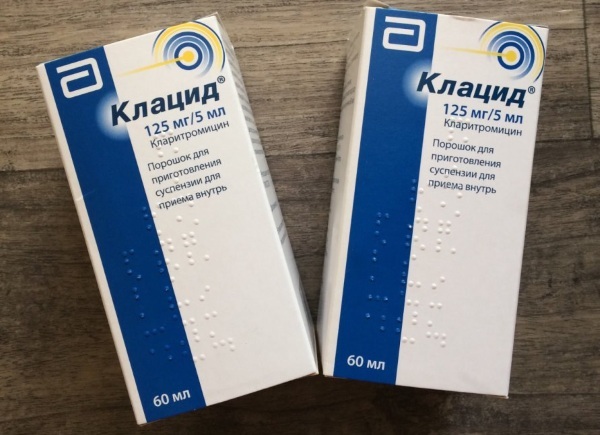
The shelf life of the medicine is 3 years.
When choosing the type of therapy for infectious diseases in children, it is necessary to proceed from such properties of drugs as compliance (presence the possibility of taking the medicine regardless of the time of the meal, taking the drug no more than 1-2 times per day, short treatment time, pleasant for child, the taste of the drug, the availability of the possibility of internal administration of the drug), the safety of the drug, high therapeutic activity.
Benefits of clarithromycin:
- exposure against the main pathogens that cause diseases of the respiratory system;
- strong antibacterial effect of metabolites;
- approximately equal level of distribution in blood and tissues;
- a long time interval between taking the drug;
- strong therapeutic effect at low dosages;
- good oral bioavailability;
- high level of portability and safety.
The drug Klacid (125 mg) has almost all the properties of an ideal antibacterial agent for the treatment of respiratory infectious diseases in children. It has a relatively low price tag. When choosing a method of treating infectious diseases in children, this is one of the best drugs.
Video about Klacida
Doctor about using claritomycin:

